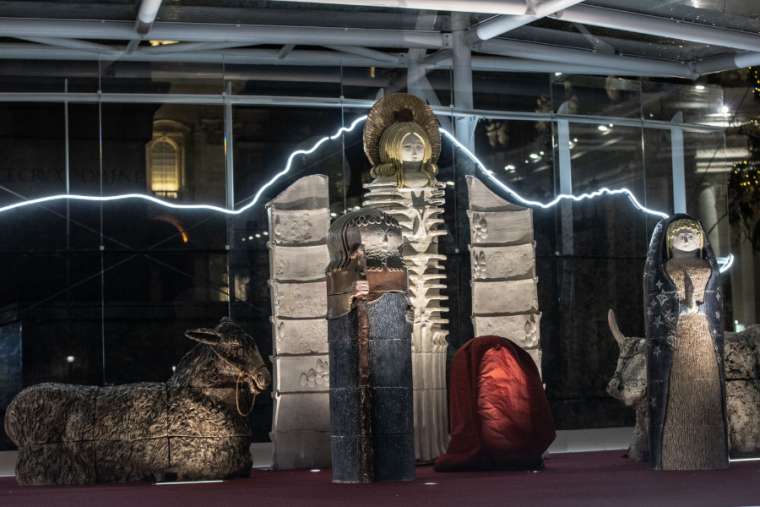“Don't embarrass us”: the art teacher defends the much-maligned Vatican nativity scene

Since it was inaugurated last Friday, the Vatican nativity scene in St. Peter's Square has aroused various reactions on social media, many of them strongly negative.
“So the Vatican crib has been revealed… it turns out that 2020 could get worse…” wrote art historian Elizabeth Lev in a post that went viral on Twitter. “Presepe” is the word for nativity scene in Italian.
But Marcello Mancini, professor at the art institute where the ceramic nativity scene was made, defended it, telling CNA that “many [art] critics have appreciated this work” over the years.
"I'm sorry for the reactions, that people don't like it", he said, stressing that "it is a nativity scene that must be framed in the historical period in which it was produced".
Since the 80s, the Vatican has exhibited a nativity scene in front of St. Peter's Basilica for the Christmas period. About a decade ago, it became customary for the scene to be donated for exhibition from various Italian regions.
This year's nativity scene comes from the Abruzzo region. The 19 ceramic figures, which include the Virgin Mary, Saint Joseph, the Christ Child, an angel, the three Magi and many animals, come from a 54-piece set made over a decade in the 60s and 70s .
The exhibit in St. Peter's Square opened alongside a nearly 30-foot tall Christmas fir tree on December 11, and immediately two unusual figures in the scene caught the attention of onlookers.
Referring to a helmeted figure with spear and shield, Rome's Catholic tour guide Mountain Butorac said "in no way does this horned creature bring me Christmas joy."
In another tweet, Butorac described the whole nativity scene as "some car parts, children's toys and an astronaut".
The soldier-like statue is a centurion and means a "great sinner," explained Mancini, a teacher at the school where the crib was made. He is also vice-president of the FA Grue Institute of Art, located in the municipality of Castelli, in central Italy, and also serves as a high school.
He noted that the astronaut was created and added to the collection after the 1969 moon landing, and was included in the pieces sent to the Vatican at the behest of the local bishop, Lorenzo Leuzzi.
Castelli is famous for its ceramics, and the idea for the nativity scene came from the then director of the art institute, Stefano Mattucci, in 1965. Several teachers and students of the institute worked on the pieces.
The 54-piece set currently in existence was completed in 1975. But already in December 1965 the “Monumental Crib of the Castles” was exhibited in the town square of Castelli. Five years later, it was shown at the Mercati di Traiano in Rome. Later he also went to Jerusalem, Bethlehem and Tel Aviv for exhibitions.
Mancini recalled that the work had received mixed criticism even in Castelli, with people saying “it's ugly, it's beautiful, it seems to me… it doesn't seem to me…” he comments: “It doesn't embarrass us. "
Regarding the reactions to the scene in the Vatican, he said: "I don't know what criticism to answer, the school has allowed the display of one of its historical artifacts." He also pointed out that it was not made by artisans but by a school.
"It is full of symbols and signifiers that offer a non-traditional reading of the nativity scene," he explained.
But people look to the Vatican "for the tradition of beauty," said Lev, who lives in Rome and teaches at Duquesne University. "We keep beautiful things in there so that no matter how horrible your life is, you can walk into St. Peter's and this is yours, it's part of who you are, and reflects who you are and the glory of who you are," he told National Catholic Register.
"I don't understand why we turn our backs," he added. "It seems to be part of this strange, modern hatred and rejection of our traditions."
The Vatican department responsible for organizing the Nativity each year is the Governorate of the Vatican City State. A press release states that the artwork was influenced by ancient Greek, Egyptian and Sumerian sculpture.
The Governorate of Vatican City State did not respond to a request for comment on Tuesday.
In his speech at the inauguration on Friday, the president of the department, Cardinal Giuseppe Bertello, said that the scene helps us to "understand that the Gospel can animate all cultures and all professions".
A Vatican News article on December 14 called the scene "slightly different" and said that those who have negative reactions to the "contemporary nativity scene" may not have understood its "hidden history".
The article quoted the letter from Pope Francis of 2019 "Admirabile signum", in which he said that it is customary to "add many symbolic figures to our cribs", even figures "that have no apparent connection with the stories of the Gospel".
In the letter, which means "remarkable sign", Francis continues by citing figures such as a beggar, a blacksmith, musicians, women carrying jugs of water and children playing. These speak "of daily holiness, of the joy of doing ordinary things in an extraordinary way, which arises every time Jesus shares his divine life with us," he said.
“Setting up the Christmas nativity scene in our homes helps us relive the story of what happened in Bethlehem,” wrote the pope. “It doesn't matter how the crib is organized: it can always be the same or it can change from year to year. What matters is that you talk about our lives “.
"Wherever it is, and whatever form it takes, the Christmas nativity scene speaks to us of the love of God, the God who became a child to let us know how close he is to every man, woman and child, regardless of their condition", he said .